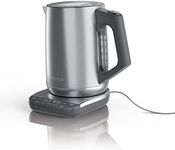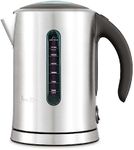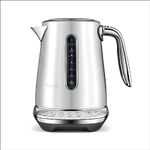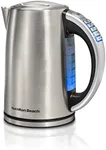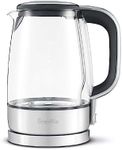Buying Guide for the Best Fastest Boiling Kettle
When choosing a kettle that boils water quickly, it's important to understand what features actually impact boiling speed and how they relate to your daily use. While many kettles claim to be 'fast-boiling,' the real difference comes down to a few key specifications. By learning what these specs mean and how they fit your needs, you can confidently pick a kettle that saves you time and fits your lifestyle.Wattage (Power)Wattage refers to the amount of electrical power the kettle uses, and it's the main factor that determines how quickly the kettle can heat water. Higher wattage means more power and faster boiling times. Kettles usually range from about 1200 to 3000 watts. Lower wattage (1200-1800W) kettles are slower but may be suitable for occasional use or smaller households. Mid-range (1800-2200W) offers a good balance of speed and energy use, ideal for most people. High wattage (2200-3000W) kettles boil water very quickly and are best for those who need hot water often or in larger quantities. Think about how often you use your kettle and how important speed is to you when choosing the wattage.
CapacityCapacity is the maximum amount of water the kettle can hold, usually measured in liters. A larger capacity means you can boil more water at once, but it may take longer to reach boiling point, even in a fast kettle. Small kettles (0.5-1 liter) are quick to boil and great for individuals or small households. Medium kettles (1-1.7 liters) suit most families and balance speed with convenience. Large kettles (over 1.7 liters) are best for groups or frequent entertaining but may take longer to boil a full pot. Choose a capacity that matches how much hot water you typically need at one time.
Heating Element TypeThe heating element is the part of the kettle that actually heats the water. There are two main types: exposed and concealed. Concealed elements are hidden under the base and tend to heat water more evenly and are easier to clean, which can help maintain boiling speed over time. Exposed elements are visible inside the kettle and may heat slightly faster initially, but can build up limescale, which slows boiling over time. For most people, a concealed element is the better choice for consistent, fast boiling and easier maintenance.
Minimum Fill LevelThe minimum fill level is the smallest amount of water you can safely boil in the kettle. A lower minimum means you can boil just a cup or two quickly, which is useful if you often make single servings. If you only need small amounts of hot water at a time, look for a kettle with a low minimum fill level to save time and energy.
MaterialKettles are commonly made from plastic, stainless steel, or glass. While material doesn't directly affect boiling speed, it can influence heat retention and durability. Stainless steel and glass kettles may retain heat better, keeping water hot for longer after boiling. Plastic kettles are often lighter and may cool down faster. If you want your water to stay hot after boiling, consider a stainless steel or glass kettle.



